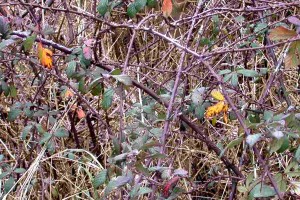Blackberry rust
History in New Zealand
Blackberry rust is native to Europe. It was first noticed in New Zealand near Rakaia in 1990 and is now widely established throughout the country. The rust is believed to have blown over from Australia, where it was illegally introduced in 1984. Another more virulent strain of the rust was officially released in Australia in the early 1990s. Since then, another eight strains of the rust have been released in Australia however no data is available on the strains present in New Zealand. The only way to tell different strains of the rust apart is with DNA fingerprinting techniques.
How would I find/recognise it and what is its lifecycle?
You may be able to see symptoms of the rust at any time of the year on flower buds, unripe fruit, or green parts of growing canes, but they are most obvious on the leaves. Look for conspicuous purple-brown spots, 2–3 mm in diameter, on the upper surfaces of the leaves. Turn the leaves over to see corresponding yellow or black powdery pustules, up to 1 mm across, on the undersides. Yellow “summer” spores are produced in spring, summer, and autumn, and they are spread by wind to cause new infections. Sticky black spores are produced in summer, autumn, and winter. They remain attached to leaves throughout winter and germinate in the spring to begin a fresh cycle of infection on the new leaves.
Image: blackberry rust, upper and lower leaf surfaces.
Heavily infected plants may sometimes look as though they have been sprayed with herbicide. The effect of blackberry rust is most apparent in autumn, when the leaves of heavily infected plants turn yellow prematurely and may shrivel and fall from canes.
Nineteen other species of fungi (that affect a range of different hosts) have been recorded from blackberry in New Zealand but most are rare or cause inconsequential damage. You may confuse blackberry rust with two other blackberry diseases. One is blackberry cane and leaf rust (Kuehneola uredinis), which forms a scattering of powdery lemon-yellow pustules on the lower surfaces of the leaves, but these do not have corresponding spots on the upper surfaces. The other is septoria leaf spot (Septoria rubi), which has similar purple-brown spots on the upper surfaces of leaves, but these never have corresponding yellow or black powdery pustules on the lower surfaces.
See Fungi commonly mistaken for biocontrol agents.
How does it damage blackberry?
The yellow “summer spores” germinate in the presence of moisture and they enter leaves through the stomata on the lower surfaces. Heavily infected leaves are usually killed, and the youngest, fully opened leaves at the cane tips are particularly susceptible. The continuous loss of leaves eventually weakens the plant as it is forced to use up the reserves stored in its root system. Rust epidemics result in shorter canes, fewer fruit and seed, and a major reduction in the number of daughter plants produced at the cane tips. The plant’s ability to invade is reduced and they do not compete as well with desirable vegetation.

Image: blackberry rust spores. Photo credit: CSIRO, license CC BY 3.0.

Image: blackberry rust damage. Photo credit: CSIRO, license CC BY 3.0.
Will it attack other plants?
Laboratory tests suggest that some native bush lawyer species (Rubus schmidelioides, R. cissoides, and R. australis), and some cultivated thornless blackberry species may be susceptible to the rust, but mild attack has only been seen very rarely on R. cissoides and once on R. australis. Commercial fungicides are available to protect cultivated thornless blackberries if necessary.
How effective is it?
The impact of blackberry rust in New Zealand has been patchy and limited. This is because the 18 morphologically distinct species that we collectively refer to as blackberry under the aggregate name Rubus fruticosus, range from highly susceptible to resistant to the self-introduced strain of blackberry rust.
To get effective control of blackberry, additional strains of the rust that would between them attack all the most problematic forms, may need to be established in New Zealand. These additional strains might arrive in due course from Australia. We would be interested to hear if blackberry that has been healthy previously suddenly becomes infected with the rust.
How can I get the most out of it?
The blackberry rust is widely established so there is little to gain by spreading it around further - plants that are not infected are possibly resistant. Slashing plants can make them more susceptible to the disease. If necessary, rust-infested plants can still be killed with herbicides.



